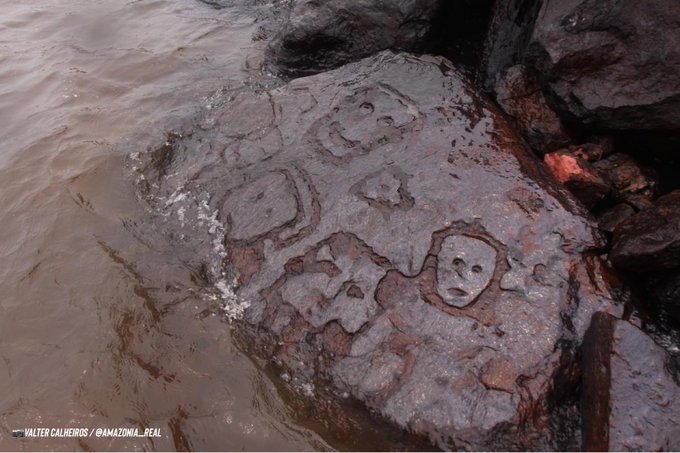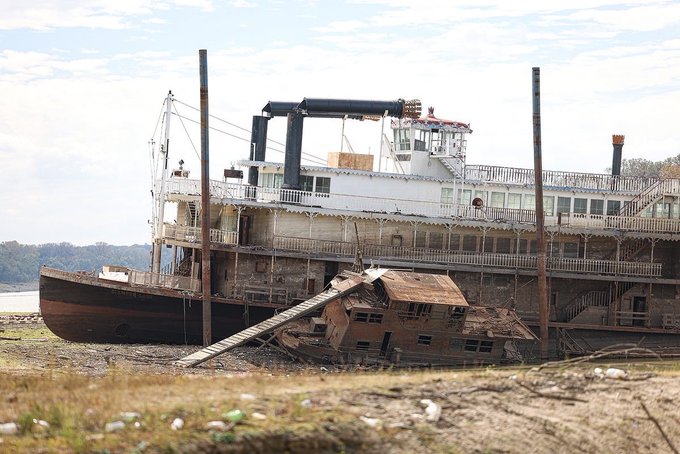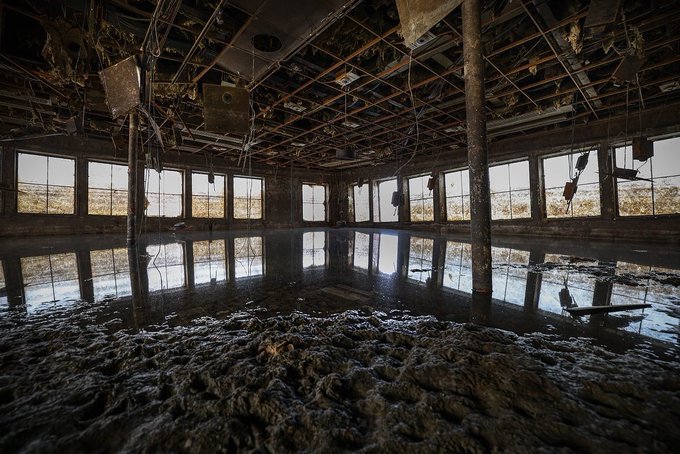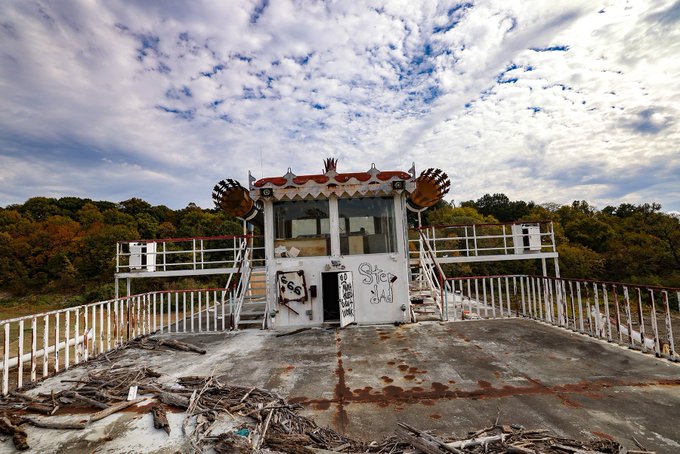As global temperatures continue to rise due to climate change, devastating droughts have gripped waterways around the world. With receding water levels exposing what was once hidden beneath, a chilling array of eerie discoveries have emerged in recent years. From abandoned railroad tunnels, to cursed cemeteries, and even eerie extraterrestrial markings, let's explore creepy things revealed by drought!
Shasta Lake Train Tunnels
In 1884, seven railroad tunnels were erected around the Shasta Route of the old Southern Pacific Railroad. However, when the Shasta Dam and Reservoir were built in 1945, these railroads were submerged 160 feet underwater!
RAILROAD TUNNEL NO. 6 IS NOW FULLY OUT OF THE WATER AT LAKE SHASTA, JULY 11, 2021. by Jeremy Tuggle For years, many of these tunnels have remained hidden underwater. However, that all changed in 2021. That summer, California suffered one of its driest years on record, receiving just 50% of its usual rainfall. By September, the water levels at Lake Shasta had dropped to just 26% of its full capacity, exposing things that had long been hidden, and which perhaps should have stayed that way. Among the first eerie discoveries were the twisted remnants of a train derailment from 1909. Explorers intrigued by the revealed railroad tunnels spotted something strange poking out of the mud: a rusted wheel, a drum bearing, and a bent axle. This accident, luckily had no known casualties. Instead, what made this accident truly unsettling was that the cause of the derailment was never determined. Was it a mechanical failure? A long-forgotten act of sabotage? Perhaps something supernatural? Whatever the truth, its discovery is certainly chilling.
But the train wreck wasn’t the only thing to resurface. As the water receded, the ghostly remnants of old railroad tunnels and bridges began to emerge from the depths. However, some courageous kayakers out there daringly decided to take a look inside the ghostly tunnels. Those who dared to venture too deep into these half-flooded tunnels found themselves swallowed by absolute darkness.
Kayaking thru Shasta Lake train tunnel #5, 8-20-2021 by Barbara Barrett Any adrenaline-junkies out there better not get their hopes up of visiting these abandoned railroads. By December 2021, considerable snow and rainfall submerged the tunnels once again. In fact, if you visited the Shasta Lake now, you’d have no idea that drowned tunnels and the wreckage of a long-forgotten train were submerged under the water’s surface!
Texas Caves
But Shasta Lake isn’t the only reservoir that has a long-hidden a secret beneath its surface. Around 7,000 miles away in Queensland, Australia, you’ll find the Texas Caves, a once-thriving cave system that vanished after the construction of Glenlyon Dam in the 1970s.
For decades, the cavern remained hidden deep underwater. That was until 2019, when Queensland was hit by a devastating drought after receiving as little as 50% of its average rainfall over the previous three years. This caused an unusually low dam level. But the drop in water, presented an opportunity for explorers to search the secrets normally submerged under the water, most notably, the forgotten
Texas Caves. One YouTuber, by the name of gravemosstake decided to do exactly that. And, based on the footage, it looked like it was nearly a grave mistake!
Cave Diving Exploration Glenlyon Dam QLD 2021 by gravemosstake After kayaking across the shallow lake, he found a narrow, suffocating cave entrance in the dried up earth. After the descending down the cave’s opening, the vlogger somehow managed to squeeze through some panic-inducing crevasses, until he finally reached a nice, wide opening. That big opening was completely flooded. Clearly, this wasn’t gravemosstake’s first rodeo, as he donned some scuba gear, before swimming through the flooded section of cave. This guy was swimming in a flooded underground cave in the middle of nowhere, with no chance of getting any help, if anything went wrong. Miraculously, he made it out. Whether that makes him brave or foolish, it's up to you.
Hunger Stones
If you had wandered along the banks of the Elbe River in Děčín, Czech Republic, during the scorching summer of 2018, you might have noticed two unsettling things. First, the water levels were lower than they’d been in years. And second, something had emerged from the parched riverbed: a series of strange, weathered stones whose surfaces were carved with eerie inscriptions.
Though it may look like remnants of some forgotten arithmetic, or cryptic symbols from an ancient civilization, the truth behind these markings is far, far more disturbing. Those are
hunger stones. Scattered throughout the rivers of Central Europe, hunger stones serve as grim warnings from the past. Each stone is marked with dates from times when the river receded to dangerous levels, when crops withered, livestock perished, and famine loomed over entire populations. Essentially, these things are history’s gravestones of suffering! One of the oldest hunger stones in Děčín dates back to 1616, though fainter traces hint at even earlier calamities as far back as the 15th century.
But if inscribed dates harking back to past droughts wasn’t spooky enough, some hunger stones also come with chilling messages too. Take one hunger stone found in Děčín, which reads: If you see me, weep. A stark reminder that, when these stones rise from their watery graves, suffering is never far behind.
Amazon Drought Exposes Ancient Face Carvings
Strangely enough, the drying rivers of Central Europe aren’t the only waterways hiding eerie engravings beneath their surfaces. The Amazon River is home to sinister snakes, monstrous fish, and this spine-chilling sight!
A drop in water levels in the Amazon River in 2023 revealed
these fearsome face carvings in the rockface of the river. Though some depicted smiles, others featured unnerving hollow-eyed expressions. So, who exactly carved these eerie emojis in the middle of the Amazon? Well, it’s not understood who made these engravings, though archaeologists believe they were carved by indigenous people who lived in the area as far back as 2,000 years ago! As for why they’re there, well that remains a mystery! Perhaps the carvings are the last traces of an unknown civilization wiped out by some cataclysmic event? Maybe these faces don’t resemble human features at all. After all, some look elongated, and distorted. Some would say alien! Could they be carvings of some sinister Martian that used to walk through the Amazon foliage?
Whatever they are, you probably wouldn't want to encounter them face-to-face! Can you imagine exploring the deep, dark heart of the Amazon in the dead of night, when all of a sudden you shine your torch, and that’s staring straight back at you!
Old Sunken Cemetery
Heading back to Europe now. Jablaničko Lake in central Bosnia and Herzegovina is normally a tourist hotspot, with thousands of visitors flocking there in the summer to enjoy the lush forestry and that picturesque lake. But probably not too many holiday-makers visited this part of the world back in the summer of 2012. That’s because this 18-mile long, 260-foot deep lake dried up after a severe drought.
While the site of one of Bosnia and Herzegovina’s largest lakes being completely dried up would be shocking enough, there was a freaky find on the dried up bed of the lake that made it even more harrowing. Horrifyingly, the drought
revealed an old sunken cemetery. That’s right, there was a cemetery at the bottom of this lake! Creepy, and a little confusing, right?
So, how did it get there in the first place? Well, here’s when things get even more chilling. The lake itself is actually artificial, created in 1953, when the nearby Neretva River was dammed to build a hydroelectric power plant. In the process, entire villages, homes, and yes, cemeteries, were submerged beneath the water's surface. Pretty heartless to purposefully flood a cemetery, don’t you think? Imagine if your future tombstone was flooded to make way for a reservoir! Who knows? Maybe the spirits of those lying under those tombstones became pretty peeed off by the decision, making Jablaničko Lake one of the world’s most cursed waterways! Scarier still, maybe the reservoir was deliberately placed here to cover up some devilish burial ground?
Dongting Lake Ancient Burial Ground
But Bosnia and Herzegovina isn’t the only place where a drought has revealed some eerie relics pointing to a troubling past. In the summer of 2022, much of China was affected by a historic drought, said to be the country’s worst in 60 years. Dongting Lake, in southeastern China, was particularly affected, losing over 70% of its water, leaving vast stretches of dry, cracked land in its wake.
Mysteriously, the decreased water levels revealed this stretch of exposed land. Emerging from the surface of the ground was a
long-forgotten ancient burial ground! Before long, archaeologists excavated the site, uncovering five ash pits and nine tombs! The burial site was poorly preserved, though they were able to estimate that it dated back some 12,000 years!
Unfortunately, less is known about the fate of those who ended up at the burial site. Were they victims of some ancient plague, or worse, human sacrifices to appease unknown gods? Whatever the truth, one thing’s for sure, this burial site is shrouded in mystery. But the dreaded discoveries at Dongting Lake don’t end there. As the water continued to recede, some peculiar, unnerving patterns emerged from the lakebed. These square blocks, each the size of a football field, were marked with a
strange labyrinth-like design.
At first glance, they appeared to be some ancient structure, perhaps a relic from a lost civilization. But no evidence of construction was found, leaving many to wonder what these strange marks really were. Some online conspiracy theorists even speculated these patterns could be the work of aquatic aliens, a sign of something otherworldly rising from the water. Fortunately, an official from the East Dongting Lake Management Committee dismissed that possibility. Instead, these patterns are traces of former ‘ai wei’. These are trenches built by fisherman into shallower areas of the lake, designed to trap and catch fish. Sounds like a reasonable explanation, right?
Still, a historic drought, revealing graves from a forgotten past and mysterious, mazey markings in the lakebed, it’s almost as if the land itself is trying to tell us something.
Blue Lake Alien Markings
If the strange patterns at Dongting Lake didn’t quite convince you that extraterrestrial life might be lurking closer than we think, perhaps this next spine-chilling discovery will. In southern Croatia, tucked away in the picturesque town of Imotski, lies the Blue Lake. Usually this is a serene, almost magical destination for tourists.
The lake, stretching over 2,600 feet, has long been a peaceful haven for hikers and sightseers. But when an especially harsh summer struck in October 2020, the unthinkable happened: the Blue Lake dried up, revealing something far from serene. Local residents were shocked to discover these sinister-looking symbols on the lakebed.
For many, their intricate design, and the fact they remained intact even when submerged underwater, suggested that these crop circle-like patterns were the work of some extraterrestrial activity in the lake!
But that’s not all. Near the final symbol in the formation, something even more cryptic was discovered, a strange inscription of three characters: M A with a heart symbol placed between them. What could that mean? Perhaps two aliens confessed their love for one another by carving their initials into the lakebed?
But before you start fearing an invasion of some loved-up aliens, chances are this isn’t the work of extraterrestrial beings, but some crafty humans. It’s likely this is actually a geoglyph, a manmade design that’s been carved into the bed of the lake. It’s believed someone headed down to the Blue Lake soon after it completely dried up, before carving the pattern into the lakebed. What they’re trying to show isn’t exactly clear, though some have suggested it could be related to some sort of cosmic alignment. Maybe they’re trying to warn us about a massive meteor that’s heading straight for Earth? As for the M heart A, well, your guess is as good as mine!
Memorial In A Dry Lake Bed Near Fallon, Nevada
On the topic of inexplicable drought discoveries, feast your eyes on this oddity! One reddit user had the displeasure of stumbling across the devilish design below while exploring a dried up lake near Fallon, Nevada. Taking a closer look, it appears like some sort of manic memorial, composed of a wooden cross, with an animal’s skull stuck on top.
If that wasn’t disturbing enough, various other animal bones were found scattered on the floor below, along with some chunks of wood, rosary beads and a metal cog. Is it some sacrilegious sacrifice site? Or maybe some playful prankster decided to freak out anyone who passed by this spot?
Columbia Space Shuttle Debris Found In Texas Lake
We couldn’t mention ‘out of this world’ finds without revealing a certain drought discovery over in Lake Nacogdoches, Texas. After weeks of intense heat and a lack of rainfall, the lake’s water level dropped by an unsettling 12 feet, exposing something truly bizarre: a strange, otherworldly object on the lakebed.
At first glance, it seemed like a mysterious and ancient relic. Maybe a long-lost dinosaur egg? Well, turns out this spooky sphere is actually a spherical aluminum power reactant storage and distribution tank, or PRSA for short. Essentially, PRSA tanks are specialized tanks used by NASA to store and distribute hydrogen and oxygen. These are necessary for the vehicle’s fuel cells to produce electricity in space. That’s all well and good, but what’s it doing at the bottom of a lake in Texas? Well, tragically this is debris from NASA’s space shuttle Columbia. When the Columbia launched in January 2003, a piece of the insulating foam broke off of the space shuttle’s external tank, striking the shuttle’s left wing. When the Columbia reentered the Earth’s atmosphere two weeks later, the damaged wing allowed hot atmospheric gases to penetrate the internal wing structure, causing the orbiter to become unstable and disintegrate. Tragically, none of the seven crewmembers aboard the Columbia would survive the disaster. The shuttle, which broke apart over Texas, scattered debris all over the state. While NASA recovered over 84,000 pieces, the discovery of this storage tank years later, served as a chilling reminder of the fatal Columbia crash all those years earlier.

Dinosaur Tracks In Texas
Less than 200 miles west of Lake Nacogdoches’ sinister spacecraft discovery, you’ll find the Paluxy River. At first glance this looks like any old creek. However, in the hot Texan sunshine, it’s not uncommon for the river to run dry during long, hot summers. And, when that happens, strange markings emerge from the riverbed.
But these are no ordinary scratches in the dirt, they’re the fossilized footprints of
dinosaurs. Among the recently exposed tracks is the "Lone Ranger trackway," a haunting collection of about 140 footprints, dating back some 110 million years.
Some of these were left by the Sauroposeidon, a colossal, 60-foot-tall, 44-ton herbivore that once roamed the Earth. But what makes the Paluxy River truly chilling is not just the size of these creatures, but the other, far more terrifying tracks that share this ancient ground. Here you’ll find the fossilized prints of the deadly 3 claw-toed Acrocanthosaurus, a fearsome predator that once stalked these lands. To call the Acrocanthosaurus scary would be an understatement! It was a bloodthirsty monster. Standing 15 feet tall and stretching nearly 40 feet long, this vicious carnivore weighed a terrifying 7 tons. The truly unsettling part? The tracks showed some of the Acrocanthosaurus prints directly on top of Sauroposeidon’s, suggesting these terrifying creatures may have hunted down the massive, 44-ton herbivores. Whoever knew droughts could uncover blood battles between long gone monsters?
Spanish Stonehenge
In August 2022, a brutal summer caused havoc for many in Spain. But one unexpected side-effect of the country’s worst drought in decades shocked the residents of El Gordo in northeast of the country. This tiny town lies just a few miles away from the Valdecañas reservoir, where the water level dropped to 28% of its capacity. As a result, these menacing monoliths arranged in a circle formation were revealed.
The monument, known as the Dolmen of Guadalperal, consists of 150 towering granite stones, some over 6 feet tall. According to archaeologists, it’s believed to date back to 5,000 BC, making it 2,000 years older than the Stonehenge! So, what’s such a mega-old monument doing underwater? Does it point to some ancient civilization of advanced aquatic creatures? In a word, no.
The Dolmen of Guadalperal was actually first discovered in 1926 by German archeologist, Hugo Obermaier. Back then it was simply a settlement on land. However, that changed in 1953, when the Valdecañas reservoir was constructed in the area, flooding the valley and submerging the sizeable stones. Their reemergence of the Dolmen of Guadalperal amid the drought left people scratching their head, pondering what exactly this thing is? Some believe the Dolmen of Guadalperal was an ancient temple, strategically aligned to mark the sunrise on the summer solstice. Others think it was used as a burial ground, where the most important figures of the ancient world were laid to rest. Who knows? Maybe the stones were once the site of darker rituals, like, sacrifices or curses? Whatever the ancient purpose of the Dolmen of Guadalperal, its sudden reemergence from the depths is certainly enough to send a shiver down my spine!
Shipwreck Casino Revealed As Mississipi River Drops
The Mississippi River has long been a symbol of American strength, unity and prosperity. However, back in 2022, large sections of this 2,300 mile-long river became unrecognizable after a massive drought receded water levels, revealing some spine-chilling secrets that were previously found hiding under the water. The most notable of all of these was a ghoulish-looking shipwreck that lay on the dried out riverbed.
Anyone else creeped out by that ruined, abandoned vessel? Interestingly though, this ship didn’t come from a bygone era. Instead, it was the ruins of the Diamond Lady, which sank just a year earlier in 2021. So,
what’s the story behind this strange shipwreck? The Diamond Lady first set sail back in 1991, with its maiden voyage departing from Bettendorf, Iowa. But this wasn’t any old vessel, it was a riverboat casino. Riverboat gambling became popular in the early 1900s due to legislation surrounding gaming. By keeping poker, roulette, and other games of chance restricted to a riverboat, business owners could evade the anti-gambling laws that were in effect on land in states along the Mississippi River.
The Diamond Lady flourished until 1999, when she was taken out of commission and replaced with bigger riverboat casinos. By 2008, the boat was permanently moored at a Marina near Memphis on the Mississippi River. However, during a winter storm in 2021, a build up of thick ice on the vessel caused it to sink into the depths of the Mississippi. But with the drought of 2022, the abandoned ship was revealed just a year later. And one daring YouTuber decided to explore what remained of the ship. Whether it’s the rotten skeletal remains of the vessel, or that eerie silence, this has got to go down as one disturbing drought discovery!
diamond lady casino riverboat like subscribe comment by Urban exploring with robert Great Salt Lake Toxic Dust
Another great American waterway that’s been vanishing before our eyes is Utah’s Great Salt Lake. In 2022, the U.S Geological Survey announced that the Great Salt Lake hit its lowest level. And with its disappearance came something far more menacing than just cracked earth and exposed lakebed.
The Great Salt Lake isn’t just drying up, it’s awakening something sinister! This lake is a terminal basin, meaning it has no outlet to flush out any harmful pollutants. As a result, the lakebed is a toxic graveyard, containing arsenic, antimony, copper, zirconium and other dangerous heavy metals, much of it residue from mining activity in the region.

Most of the exposed soil is still protected by a hard crust. But as wind erodes the exposed crust over time, those contaminants become airborne. And considering some 800 square miles of lakebed is exposed, covering an area nearly three times the size of New York City, that’s a potential environmental ticking time bomb! Clouds of dust make it difficult for the 2.5 million people living close to the lake to breathe. More sinisterly, the metals in the soil are incredibly dangerous. Take arsenic. Exposure to arsenic in the air, can lead to irritation of the nose and mouth, breathing difficulties, and inflammation of the lungs. While in more severe cases it can even lead to lung cancer.

But the nightmare doesn’t stop there. The Great Salt Lake is also becoming a silent assassin of the planet itself. According to scientists, the drying lake is now becoming a significant contributor to climate change. Researchers found that the drying lake bed emitted 4.1 million tons of carbon dioxide and other greenhouse gases into the atmosphere in 2020 alone. For context, that’s equivalent to the total annual emissions of around 140 commercial planes! Who knew such a wicked wasteland could lie within a dried out lakebed?
Buddhist Statues Revealed In Yangtze River Drought
Across the other side of the world in China, the Yangtze River, aka, the third largest river in the world, has also experienced its fair share of hardship from the ever-warming climate. In the summer of 2022, a 70 day heatwave saw the Yangtze water levels drop down. Months of baking drought uncovered this usually submerged sight, found on top of Foyeliang Island reef in the middle of the Yangtze River.
Three Buddhist statues carved into the rock archways emerged from the dropping water level. In rare cases, mummified monks have been found in similar looking Buddhist statues. So, had the ancient corpse of some religious figurehead suddenly emerged from under the water? Thankfully not. Turns out these statues are just over 3 feet-tall, making it practically impossible for any humans to be encased within.
Even still, these statues shouldn’t be ignored. Archaeologists traced their origins back to the 15th century, when they were carved into the stone as guardians, designed to bring protection and prosperity to sailors who were travelling along the Yangtze. Nowadays however, the sight of these long lost statues is less of a good omen, and more of a warning of worsening droughts, pointing towards a potential climate catastrophe! If you were amazed at these creepy things revealed by drought, you might want to read about
mysterious discoveries found in dried bodies of water. Thanks for reading!


































